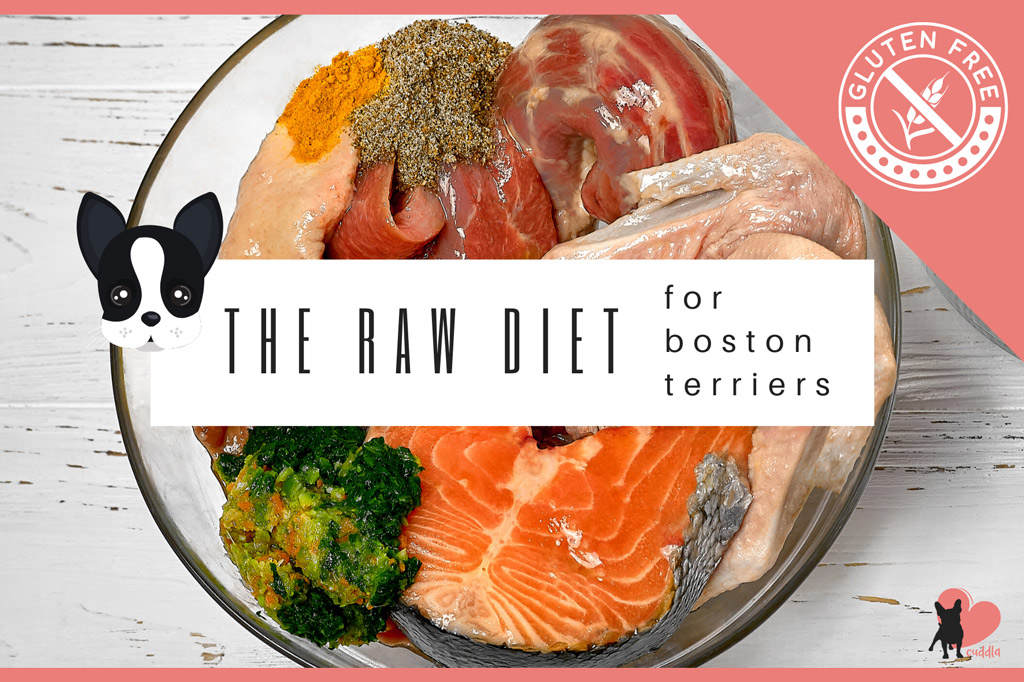
Are considering raw feeding? Is the raw diet (also known as BARF) appropriate for your Boston Terrier? Why dome dog experts and holistic veterinarian recommend to feed your dog a raw diet?
Let’s me introduce you to the Boston Terrier raw diet. 🙂
Boston Terrier Raw Diet
In Boston Terrier Diet blog post, I went through Boston Terrier’s dietary needs. Knowing what macronutrients (proteins, fats and carbohydrates) and micronutrients (vitamins and minerals) your dog requires to stay healthy is key to a balanced diet.
But, how can I make sure that my Boston Terrier gets all the nutrients needed for a healthy and long life?
The answer is by following a balanced and species-appropriate diet, i.e., a raw diet.
But don’t take my word for it, let’s see the facts:
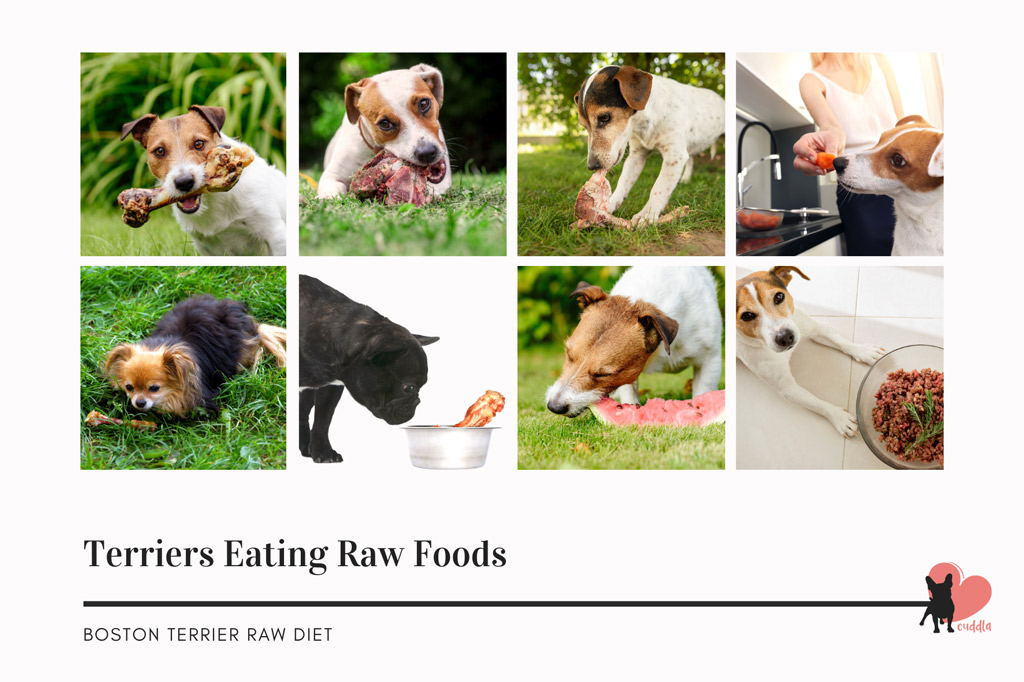
Why Should I Feed My Boston Terrier a Raw Diet?
From a genetic standpoint, domesticated canines (dogs) are essentially the same as their wild counterparts (wolves), who are carnivores. Their DNA sequence only varies about 0.02%.
So nutritionally speaking, dogs are still wolves.
This means that a dog’s primordial (original) diet is essentially that of the wild wolf. Dogs must eat fresh and raw whole animals for optimal health.
However, since our pet dogs don’t hunt for their food, we need to provide to what is closest to wild prey.
Dog are carnivores and evolved to consume a low-carbohydrate diet. But for the last century, the majority of dog owners have fed their dogs a high-carbohydrate, low-moisture diet, i.e. kibble.
This processed diet has created significant metabolic and physiologic stress in our dogs. It has even become the root cause of most of the inflammatory processes and degenerative disease we see in veterinary medicine today.
Also, it contributes to cancer development due to their high content in aflatoxins in the ingredients (corn, wheat, rice, nuts, and legumes) and heterocyclic amines due to processing (source).
For Boston Terriers, this means that processed food can be responsible for flatulence, sensitive and food allergies now (and further health problems later on).
However, by feeding your Boston Terrier a balanced and species-appropriate diet you will avoid:
- Illnesses like diabetes, cancer and obesity.
- Problems like flatulence and food allergies (sadly, both common for the Boston Terrier breed).
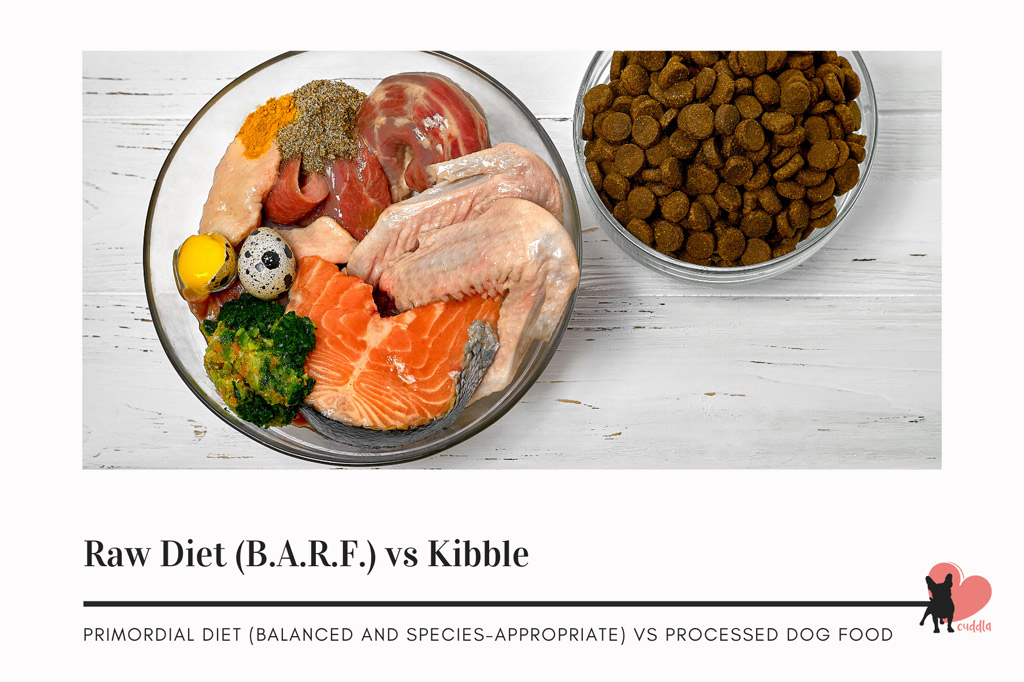
What Is The Best Diet for a Boston Terrier?
As a dog owner, you always want to feed your Boston Terrier the best diet to promote a healthy and long life.
Starting from the most ideal, here’s the ladder of progression on what is the best diet:
- The Primordial Diet: Ideally, you would feed a whole wild prey to your dog. This provides the right balance of nutrients. -> Very unlikely nowadays.
- The Raw Diet: If nº1 above is not possible, you would feed a whole domestic animal that is grass-fed and grass-finished. Domestic animals have higher levels of fat and lower levels of protein. -> Not achievable for all raw feeders.
- The Frankenprey Diet: If nº2 is not possible, you would feed parts of different domestic animals that are grass-fed and grass-finished. You will have to balance the nutrients yourself. -> A more likely scenario.
- If not, you would feed a whole domestic animal that is grain-fed. This diet has too much fat and not enough vitamins and minerals.
- If not, a fortified commercial raw diet that has synthetic vitamin E. You probably need to add calcium to the diet too.
- If not, a processed commercial “raw” diet. It’s questionable if it’s raw since it has been processed. It has more fat and they are not balanced. Also, it is deficient in vitamins and minerals.
- At the very bottom, you have commercial and processed dog foods like kibble and canned food. It has the wrong balance of nutrients for carnivores. Also, it is deficient in vitamins and minerals.
The closer the diet is to its primordial form (nº1), the fewer deficiencies your pooch is likely to have.
However, the further away from your dog’s diet is from the primordial diet, the higher the deficiencies. Also, the balance of the nutrients will be completely off.
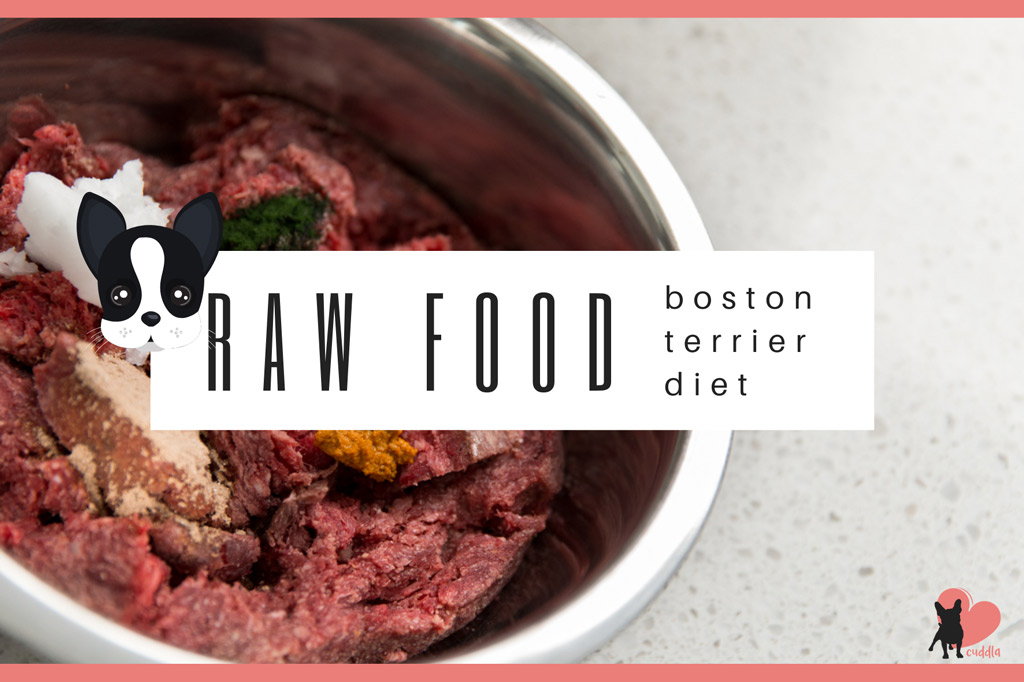
Homemade Raw Diet for Boston Terriers
Before I get started, here’s a disclaimer:

I am not a veterinarian, so always check with your vet before changing your Boston Terrier’s diet to avoid unexpected consequences and health issues.
However, I do have knowledge on dog nutrition, raw feeding and dietary needs.
The Raw Diet is also refered to as:
- The Primordial Diet.
- The B.A.R.F Diet (Biologically Appropriate Raw Food).
- The Species-Appropriate Diet.
- The Bones and Raw Food.
This type of diet consists of feeding your dog a primordial diet (their original diet). This means to feed raw whole animals or animal parts.
A whole animal includes all its part: meat, bones, organs, glands, fur, feathers, skin, etc. Every part of an animal provides nutrition, preventing any deficiencies.
The Ingredients in The Raw Diet
Raw feeding ensures a balanced diet that is species-appropriate (for dogs). A raw diet includes:
- High-quality protein.
- Low animal fat.
- A balanced ratio of Omega-3 and Omega-6 fatty acids.
- High moisture content.
- A low amount of vegetation (mimics prey’s stomach contents).
Which also means:
- No fillers like grains, corn, potatoes or other starches that don’t belong to the primordial diet.
- No artificial colouring or preservatives.
- No harmful chemicals.
The macronutrients and micronutrients are balanced in the primordial diet and on the modern raw diet like this:
| Ingredient | % of Calories | Grams/1,000Kcal | % as Fed |
| Protein | 49% | 123g/1,000Kcal | 20% (total 33-40%)* |
| Fat | 44% | 49g/1,000Kcal | 10% |
| Carbohydrate | 6% | 15g/1,000Kcal | 5-10% |
| Bone | 12% (adults) and 15% (puppies) | 12-15% | |
| Organs | 10% (only liver) and 15% (all organs) | 15% |
*Total of proteins includes the proteins found in organs and bones too. The 20% comes from meat and fish.

Pros and Cons of The Raw Diet
Like every diet, it has its advantages and disadvantages:
Advantages
Nutritionally speaking, the raw diet is the richest in nutrition and the diet that dogs have been eating for thousands of years.
- High in protein (33-40%) and the right protein (animal source). The quality improves significantly when the animal is wild or pastured.
- Low amount of fat and balanced (omega-3 and omega-6).
- Protein and fats are balanced (2:1 ratio).
- High in calcium and phosphorus because of the raw bones (12-15%).
- Rich in vitamins and minerals due to the organs (15%).
- Low in carbohydrate (5-10%) but the right ones to supplement vitamins and minerals naturally.
- High in moisture (70%).
Also, from a physiological and anatomical point of view, a dog’s stomach is adapted to consume raw food. A dog’s gut has an acidic pH that is able to digest raw meats and bones, plus extract the nutrition from them.
In conclusion, the raw diet is complete, it has no nutritional concerns.
Disadvantages
- Price concerns: It can be expensive, especially because you are sourcing a variety of animals that are grass-fed and vegetation that is organic.
- Parasite concerns: Wild prey and pork can carry worms (tapeworm and roundworm).
- Solution: You need to freeze the meat for a period of time to eliminate them.
- Bacteria concerns: Salmonella is common in poultry like chicken; grass-fed options are always safer. But remember that the FDA is compliant with 10% of salmonella found in poultry for humans.
- Solution: Washing your hands after handling raw food and washing your dog’s bowl is what you need to do. Also, add apple cider vinegar to kill 80-99% of bacteria in your dog’s meal. Fermented vegetables also help. Finally, dog’s with an acidic gut are equipped to handle pathogenic bacteria.
- Time concerns: Preparing a raw diet takes time. You need to chop all the meats and bones. Then, you need to puree the vegetables and fruits for maximum benefits.
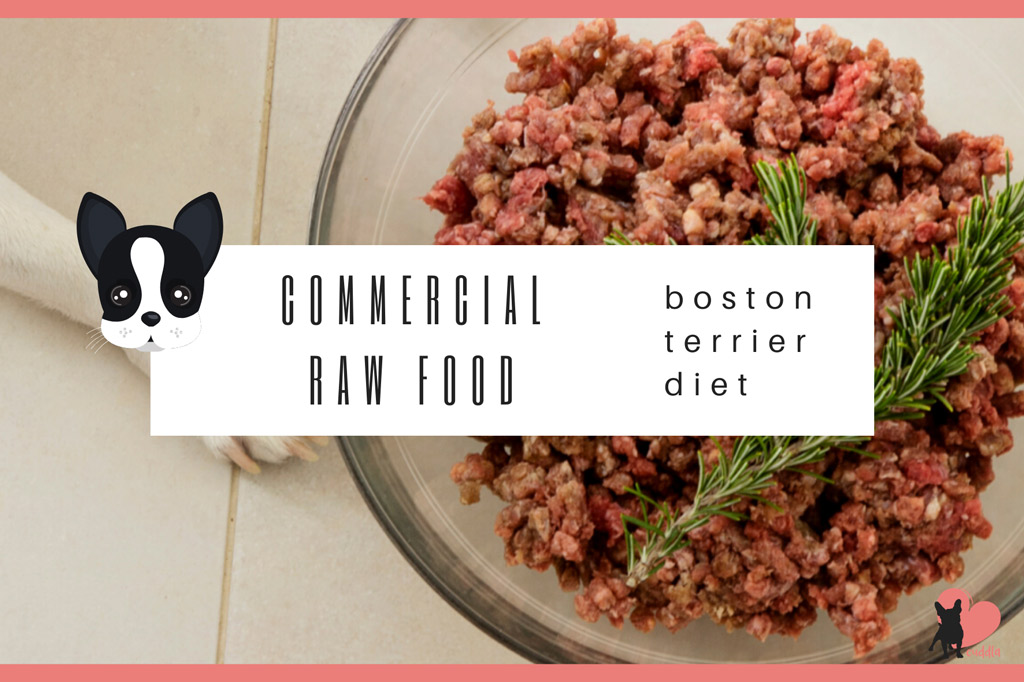
Commercial Raw Diet for Boston Terriers
Commercial raw food for dogs can be a closer looking alternative to the raw diet for your Boston Terrier.
On their “Guaranteed Analysis” you can see the four critical food components (protein, fat, fibre and moisture) percentages. The food should be analyzed on Caloric Basis since it holds moisture and it’s the suitable metric for a high calorie nutrient dense foods like raw diets.
Also, they follow AAFCO‘s requirements. But they don’t apply to raw food since their tests were done on kibble fed dogs.
Pros and Cons of The Commercial Raw Diet
Although its a raw diet, it differs more from the primordial diet. That’s why it has more disadvantages than the raw diet.
Advantages
- Still closer to the primordial diet and more natural than processed pet foods like kibble.
- Good source of protein.
- Low carbohydrate content. Both Homemade and commercial raw diets are a good choice for:
- Gassy Boston Terriers and those who suffer from inflammation.
- Boston Terriers with a sensitive stomach and/or food allergies.
Disadvantages
- Nutritional concerns:
- Protein and fat are not balanced. The food has too much fat, the ratio should be 2:1 (twice as much protein than fat).
- Solution: Aim to get close to 2:1 ratio. They have a 1.6:1 ratio in best cases or a 1:1 ratio in the worst.
- Lower in vitamins and minerals.
- Solution: Supplement with vegetables and fruits.
- Protein and fat are not balanced. The food has too much fat, the ratio should be 2:1 (twice as much protein than fat).
- Processing concerns: It stops being raw when manufacturers use HPP (High-Pressure Pasteurization) since they kill the bad and the good bacteria. It also causes nutrient loss.
- Solution: Look for commercial raw food brands that don’t use HPP.
- Price concerns: Still more expensive than kibble and canned food. High-quality protein is always more expensive than the meat residues and other ingredients used in processed pet food like kibble.
Best Raw Diet for Boston Terriers
When choosing a commercial raw diet for your pooch, you should:
- Avoid HPP foods. If a food needs to be sterilized, it’s not high quality. Plus, HPP kills beneficial bacteria and causes nutrient loss.
- Food must be analyzed on a Caloric Basis. Otherwise, you won’t know if the food is deficient or not.
- Watch out for the fat content. You should aim to get the closest you can to a 2:1 ratio. Remember that the more fat, the less protein, vitamins and minerals.
- Avoid added synthetic vitamin and minerals. Synthetic supplements don’t perform like their natural counterparts. It’s best to add vegetation to compensate for deficiencies.
- Stay away from raw foods containing fish oil. The PUFAs in fish oil have the largest carbon bonds, which makes them very easy to oxidize. The food can get rancid when the freezing process punctures those carbon bonds.
Here’s a range of commercial raw food, which is freeze-dried. Brands like Stella & Chewy’s uses grass-fed animals, wild-caught fish and organic veggies and fruits. But they also use HPP.
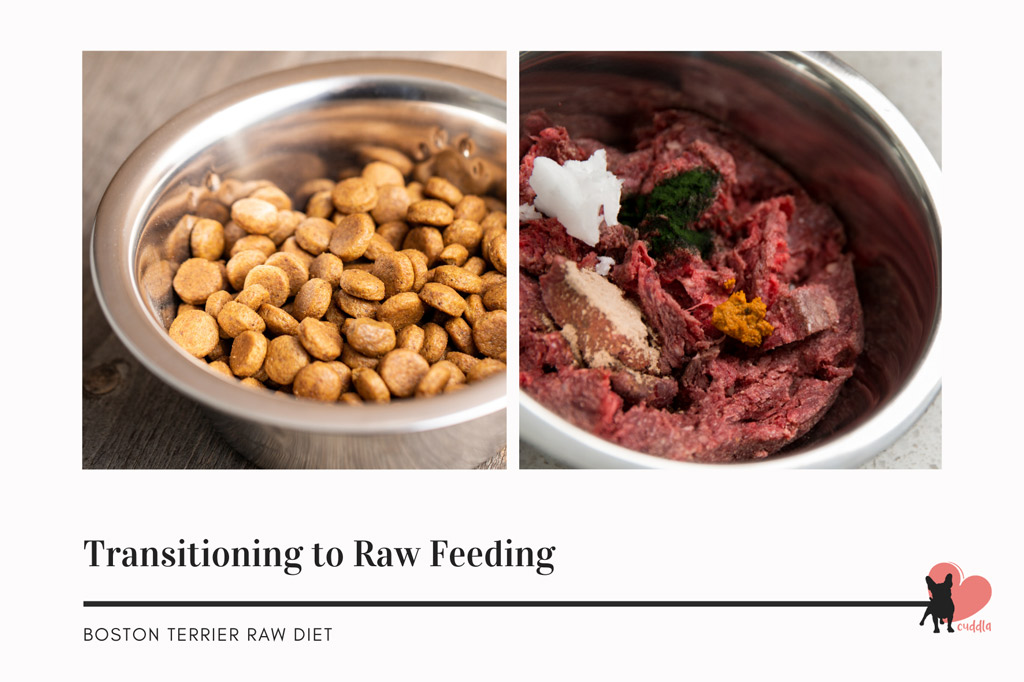
Transitioning to The Raw Diet
Boston Terriers that are wined and raised following a dry diet (kibble) have a few barriers to overcome when switching to the raw diet:
- Flavour fatigue: If puppies are only fed a limited amount of flavours during their first 4-6 months, they are less likely to accept new flavours later on. Over time, they will develop a “flavour fatigue,” making them very picky eaters. This fact will make a switch to raw very hard.
- Pre-natal chemosensory learning: Dogs, like most mammals, develop preferences to what they have been exposed to whilst in their mother’s womb. Pet companies know this, so if the dam is fed a certain type of kibble, her litter will be predisposed to it too.
- The Palatant: Processed pet foods spray kibble with a substance (fat, sugar, salt, etc.) that encourages dogs to eat more than they need. The longer a dog has been fed kibble (especially if she only has eaten that), the harder it is to make the switch to a raw diet.
- The breed, health and age of your dog also play a role. The influence the amount of time your dog needs to make the switch.
Ways of Switching to The Raw Diet
There are two ways to switch to the raw diet:
- Cold turkey: If you are dealing with a pup or a healthy adult with a history of some variety in their diet, you can switch immediately.
- Gradually: If you are unsure about how your Boston will respond to the change or if your dog has a history of digestive upset, then you want to take your time with the transition.
Either way, check with your vet to see what is preferable for your Boston Terrier.
The main cause of issues when switching to raw is that it can take up to a week for your Boston’s stomach to go to its normal ph (2 or below), which is acidic.
Ensuring a Smooth Transition to Raw
Transitioning your Boston Terrier to a raw diet can take 1 to 2 weeks.
Here’s how you can smooth the transition:
- A week before the transition, start giving your Boston terrier probiotics specific to dogs. This supplement will lower the ph of your dog’s gut, transitioning from an alkaline gut (above 2) to an acidic gut (2 and below).
- The stools will determine the speed of the transition. Feed 1/4th of the meal as raw and then watch the stools. If they are a little loose, stay on that feeding proportion until they are firm. If they are runny, reduce the amount of raw. Once they are firm, you can gradually increase the number of raw calories that you add to her daily meals.
- Add apple cider vinegar to lower the ph. This vinegar makes the food safer for your Boston and enables to body to absorb more minerals. You can add 1tsp to 1ts for 50 pounds of body weight.
- Start with one protein source.
- Add organ meats and fatty meats later on since they can cause loose stools.
- Don’t feed bones right away. If bones are feed when the ph is still high (alkaline), there’s a potential for blockage.
When transitioning a puppy, you could use a commercial raw diet (pre-made raw diet) that has the right amount of calcium or add bone dust until your pup is ready to chew on bones.
Note: Mixing kibble and raw for a prolonged period of time is not a good idea. This only increases the risk of pathogenic bacteria since your dog’s gut is not fully alkaline or fully acidic.
Feeding a Raw Diet
There are many factors that influence how much and how often you feed your doggie:
- Breed: Boston Terrier.
- Size: How big your pooch is will influence how much food she needs.
- Age: Depending on the life stage, your dog has different nutritional needs. For example, puppies need milk as a major food item while an adult dog will need meat.
- Bodyweight and body condition: If your pooch suffers from obesity or has gained weight recently, you should limit her food intake.
- Metabolism: This has to do with how your dog digests food. Boston Terriers have a fast metabolism with high needs for energy.
- Activity levels: Active Boston Terriers need more food intake, for instance.
- Spayed or Neutered: Boston Terriers that have been spayed (female dogs) or neutered (male dogs) have a greater risk of becoming overweight than dogs whose sexual organs are intact (source).
- Environmental Variables (Temperature): Usually, during hot temperatures, a dog’s appetite diminishes.
- Etc.
Let’s have a look at how many calories per day does your Boston Terrier need.
How Many Calories Boston Terrier’s Eat
How many calories should a Boston Terrier eat?
According to a study published by National Research Council of the National Academies, a 10 pound (4.5kg), active and adult Boston Terrier should eat 404 calories per day.
| Age | Weight | Calories Per Day |
| Young Active Boston Terrier | 10 lb (4.5kg) | 436kcal/day |
| Adult Active Boston Terrier | 10 lb (4.5kg) | 404kcal/day |
| Senior Active Boston Terrier | 10 lb (4.5kg) | 327kcal/day |
| Pregnant and Nursing Boston Terrier | 10 lb (4.5kg) | 518kcal/day |
| Senior Inactive Boston Terrier | 10 lb (4.5kg) | 296kcal/day |
For more precise and individual metrics, use Pet Alliance Nutrition calorie calculator here.
Then, how much raw food should I feed my Boston terrier?
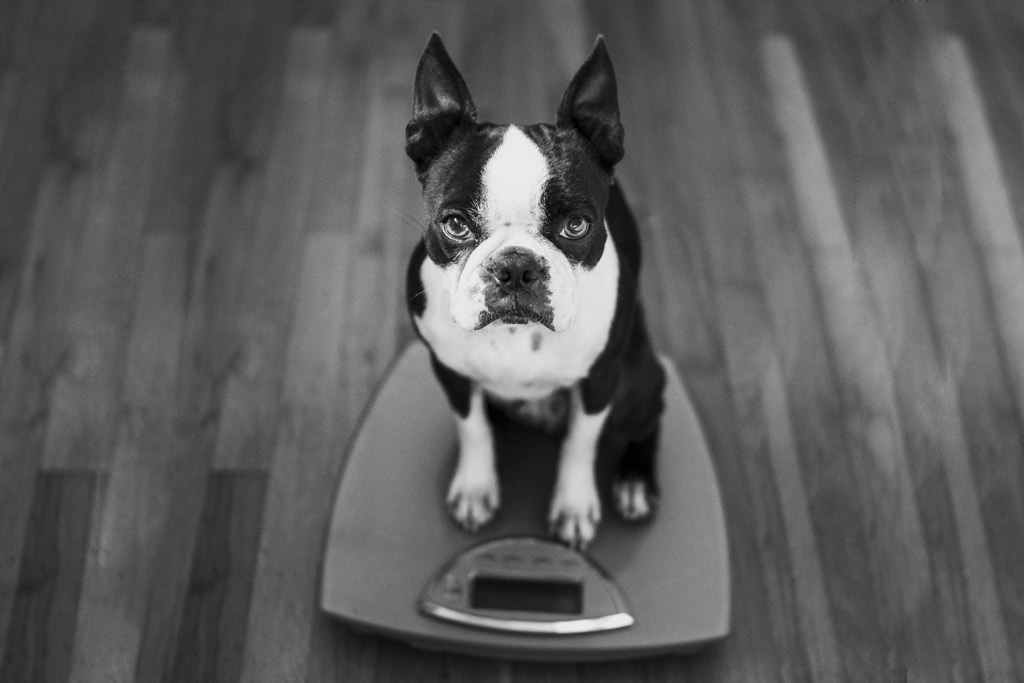
How Much To Feed Your Boston Terrier
There are three ways that you can determine how much food your dog needs. You can calculate your Boston Terrier’s caloric requirements by:
- Calculating MER (Maintenance Energy Requirements): It’s not easy since you have to use a series of mathematical formulas.
- Bodyweight: For adults, you will feed 2-3% of your dog’s ideal body weight and 4% for puppies.
- Eyeball: Probably what you will end up doing in the long run. Although from time to time I recommend you to weight your dog’s food to avoid overfeeding!
How Much to Feed an Adult Boston Terrier
Using the bodyweight method (%2.5 body weight), here’s an average on how much to feed an adult Boston Terrier per day:
| Adult Weight | Raw Food Serving Range |
| 5-10 lbs (2.3-4.5kg) | 57.5-112.5g/day |
| 10-15 lbs (4.5-6.8kg) | 112.5-170g/day |
| 15-20 lbs (6.8-9.1kg) | 170-227.5g/day |
| 10-25 lbs (9.1-11.3kg) | 227.5-282.5g/day |
How Much to Feed a Boston Terrier Puppy
For Boston Terrier puppies (%4 body weight):
| Puppy Weight | Raw Food Serving Range |
| 5-10 lbs (2.3-4.5kg) | 92-180g/day |
| 10-15 lbs (4.5-6.8kg) | 180-272g/day |
| 15-20 lbs (6.8-9.1kg) | 272-364g/day |
| 10-25 lbs (9.1-11.3kg) | 364-452g/day |
Boston Terrier’s Feeding Schedule
Again, the feeding schedule and the number of times you feed your Boston Terrier depends on the dog’s age. Setting a feeding schedule will help your pooch to follow her daily routine.
Remember that dogs thrive with consistency.
On average, you can feed your adult Boston Terriers twice a day: breakfast and dinner. Giving two meals a day may make it easier for the dog to digest the food (avoiding getting bloated) and helps control hunger.
Puppies, on the other hand, need to eat more frequently. Here’s a guideline on meal schedule:
| Age | Number of meals |
| 8 weeks | 5 meals |
| 3 months | 4 meals |
| 6 months | 3 meals |
| 12 months + | 2 meals |
Read also: How Much to Feed Boston Terriers? And How Often?
The Benefits of Fasting
Consider fasting your adult Boston Terrier every week or two.
Fasting has many benefits:
- Removes waste and free radicals.
- Reduces inflammation.
- Removes waste from cells.
- Can lengthen your Boston Terrier’s lifespan.
Note: Always check with your vet first. Also, never fast puppies and sick dogs.
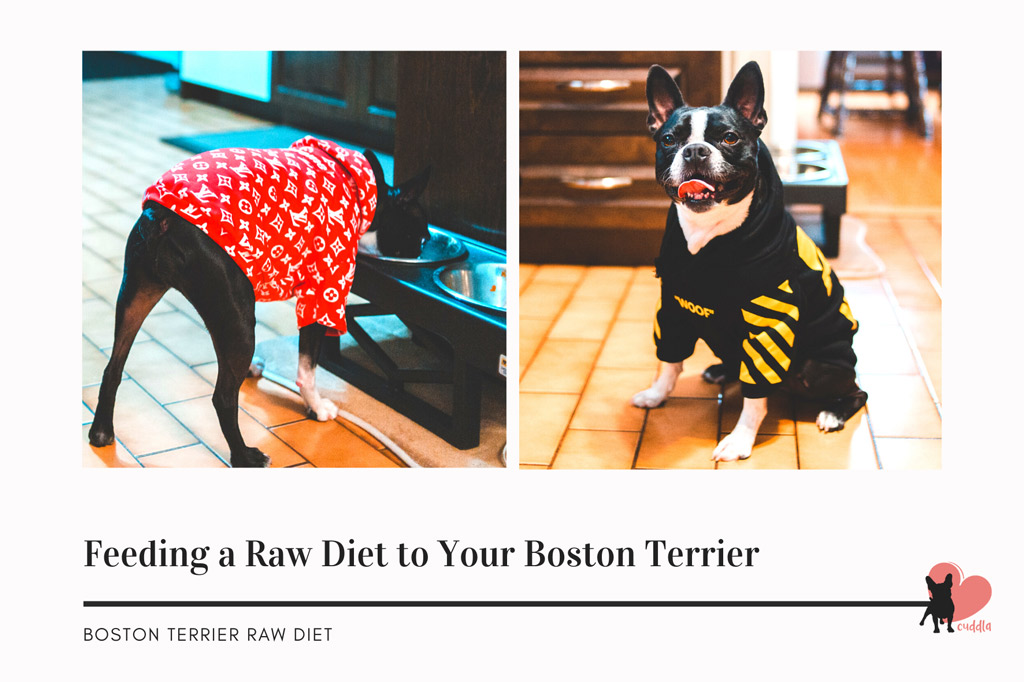
Ways to Feed Boston Terriers
If you decide to feed your Boston Terrier twice a day…
You should divide the total amount of calories into two meals and space them during the day; you can give your dog breakfast and dinner, for example.
Also, treats should be accounted for on your dog’s daily food intake (i.e., the total amount of calories per day). That’s why you should put aside a small portion of your Boston Terrier’s meal to reward her good behaviour.
Boston Terrier Treats – even very healthy ones – should not constitute more than 10% of your dog’s daily food intake.
Once you know how much and how often you are going to feed your Boston Terrier… There are three ways to feed your pooch:
- Feeding bowl: Establish a feeding area in your dog’s safe zone where you can place your dog’s bowls for food and water.
- Hand-feeding: You can decide to hand feed your Boston whilst training, for example.
- Dispenser toys: Use a rubber dispenser toy like a Kong.
- Slow-feeders: These are great for preventing flatulence in Boston Terriers. The shape of their snouts and speed-eating habits makes them swallow more air when eating and drinking. These two facts cause gassiness.
- A Lickimat Slow Feeder for smoothies, apple sauce and other pasty meals.
- Another option is a raised slow feeder bowl, which features a raised centre to make swallowing large amounts of food impossible for your dog.
